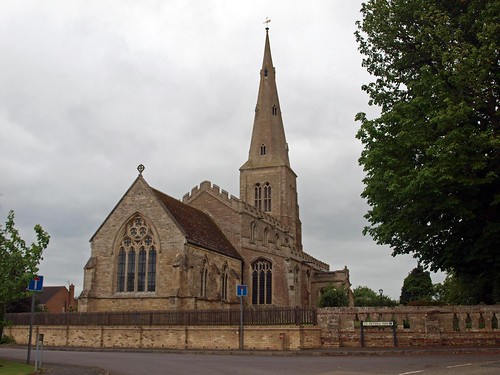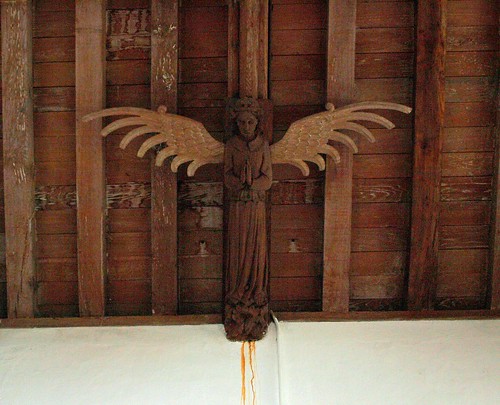ALL SAINTS. A very fine, slender Perp W tower with set-back buttresses, pairs of two-light transomed bell-openings, a top frieze, and a broach spire with low broaches and three tiers of lucarnes in alternating directions. Inside, it is evident that the tower was built independent of the church. The start of a vault in the tower is preserved. The chancel is later C13, i.e. the Victorian geometrical tracery of 1863 (by Scott) represents the style correctly. Original are the shafts of the E window, the chancel arch with stiff-leaf capitals, a little of the sill-frieze, and the priest’s doorway. Of the same date approximately is the re-set N aisle doorway. But the aisle itself and the S aisle, both embattled, and the embattled clerestory and the N porch (with leaf spandrels to the entrance) are all Perp. The four-bay arcades have piers with the standard moulded section and arches with two sunk-quadrant mouldings. Good nave roof with carved braces, embattled collars, angels against the feet of the secondary principals, and figures against the wall-posts. The N and S aisle roofs are similar, but also have ornamented bosses. - FONT. Octagonal, Perp, with quatrefoils and one other simple motif. - STALLS. Victorian, and, curiously enough, in the E.E. style. - BELL. One by John Walgrave, c.1420-30. - PLATE. Cup of 1725-6. - MONUMENT. Badly defaced effigy of a Lady, C14, the effigy carved on a coffin lid and the coffin preserved too.
ELLINGTON. It has thatched cottages that have been here 300 years, and a tree-shaded green with a pond. It has a stream flowing to the Alconbury Brook; we may be sure that Pepys knew it, for his father lived here and here the diarist’s sister, Paulina, found a husband in John Jackson. “We must find her one,” he wrote, “for she grows old and ugly.”
The fine church he would know has a tower and spire of the 14th century and a chancel arch of the 13th. The finely panelled font is 500 years old. There are bits of old red and yellow glass in the windows, and traces of a Doom picture were fading over the chancel arch when we called. An oak chest with three locks is 17th century, and another is older still and has simple ornament. Two bells have called the people to church as long as America has been known.
There is a 13th century coffin in the north aisle, and the lid of another has been used as a coping-stone on the churchyard wall. Here is kept one of the rare long hooks for drawing thatch off a burning roof, reminding us of some we have seen in Kent and Sussex.
It is delightful to find so many angels in Ellington. A fine company they make on the roofs of the nave and aisles, the work of clever 15th century carvers. We counted eight with outspread wings above the nave, and ten figures who are perhaps apostles. Other time-worn saints and angels look down on the aisles, and among the bosses of the north aisle are still more angels, with much foliage and a swan.
The fine church he would know has a tower and spire of the 14th century and a chancel arch of the 13th. The finely panelled font is 500 years old. There are bits of old red and yellow glass in the windows, and traces of a Doom picture were fading over the chancel arch when we called. An oak chest with three locks is 17th century, and another is older still and has simple ornament. Two bells have called the people to church as long as America has been known.
There is a 13th century coffin in the north aisle, and the lid of another has been used as a coping-stone on the churchyard wall. Here is kept one of the rare long hooks for drawing thatch off a burning roof, reminding us of some we have seen in Kent and Sussex.
It is delightful to find so many angels in Ellington. A fine company they make on the roofs of the nave and aisles, the work of clever 15th century carvers. We counted eight with outspread wings above the nave, and ten figures who are perhaps apostles. Other time-worn saints and angels look down on the aisles, and among the bosses of the north aisle are still more angels, with much foliage and a swan.



No comments:
Post a Comment